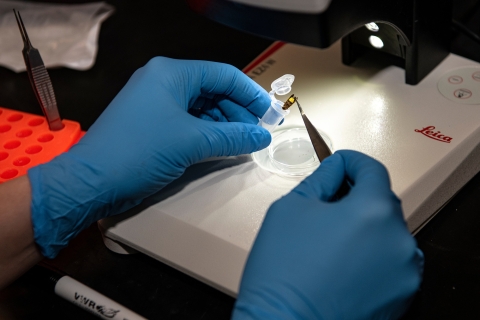
Bucknell Study Illuminates the Surprising Sense of Smell in Fireflies
July 14, 2025
Professor Sarah Lower and her students collect fireflies at the Forrest D. Brown Conference Center in Cowan, Pa. Photo by James T. Giffen, Marketing & Communications .
A new study led by Bucknell University Professor Sarah Lower, biology, suggests that Photinus pyralis, the common eastern firefly, may be using more than just its iconic flash to find a mate. Published in BMC Genomics, the research uncovers genetic evidence that smell — not just light — may play a key role in firefly communication and courtship.

Lower conducts analysis on a firefly. Photo by Emily Paine, Marketing & Communications
"Fireflies have always been seen as a visual species. They light up, and we assume that's how they talk to each other," says Lower, who helped map the firefly genome in 2018. "But we looked at genes for odorant receptors — the ones tied to smell — and found there's a lot more going on than we thought."
The team identified 102 odorant receptor (OR) genes in P. pyralis, several of which were strongly expressed in the their antennae. One, in particular, showed significantly higher expression in male fireflies — a potential clue to scent-based mate tracking.
"That caught our attention," Lower says. "It's the only odorant receptor gene that was turned on more in males than in females. In adult males, the primary goal is to find a female to mate with. This gene might help them do that through close-range chemical signals."
While many insects rely heavily on smell to find mates — silk moths and Japanese beetles among them — fireflies have long been seen as light-driven communicators. This new evidence challenges that assumption.
"We were not expecting to see this in P. pyralis, which is one of the most common firefly species in North America," Lower says. "This suggests that even in these species with flashing adults, smell may be part of a two-step system — light to get close, then scent to seal the deal."
The research was a cross-disciplinary effort. Bucknell Professor Doug Collins, chemistry, co-authored the study along with undergraduate Susan Deering '26 and alumni Samuel Pring '23, Hanh Tran '20 and Katherine Martinson '24. Additional collaborators came from the University of Wisconsin-Oshkosh, National Jewish Health, University of Colorado Denver, Middlebury College and Penn State.
Using RNA sequencing, the team compared gene expression in male and female antennae — the primary olfactory organs — and hind legs, which are not involved in smell. Their standout finding was PpyrOR6, an OR gene with male-biased expression, hinting at sex-specific olfactory functions.
"This could help the male locate a female or even avoid predators," Lower explains. "Some female-mimicking species lure in unsuspecting males and eat them — the so-called femme fatale fireflies. Smell might be part of how males navigate that risk."
The genetic work is being complemented by chemical analysis in Collins' lab, where the team is exploring which compounds may activate specific receptors.
"We are working through a few seasons of data to figure out if there might be molecules that are the 'key' to the receptor's 'lock,'" Collins says. "The genetic data can't tell us that directly, so we need to approach the question from another angle."
The implications extend beyond fireflies. Odorant receptors are already used in integrated pest management — including pheromone traps for species like Japanese beetles and spongy moths. Unlike visual signals, which can be disrupted by light pollution, chemical communication is harder to interfere with.
"Smell is a much harder modality to disrupt," Lower says. "Light pollution is everywhere, and it affects both people and animals. But olfactory signals may stay clearer, which is another reason this discovery is so interesting."
The team plans to expand their research to other firefly species and life stages. Collins is already analyzing chemical data from a wide range of species to see if similar patterns emerge.
"As a part of this collaborative project, we’ve collected a lot of chemical data from fireflies," Collins says. "The genomic study gives us great goalposts to look at while we (figuratively) sniff our way through the chemical data."
Firefly season in Pennsylvania typically begins in mid-June, with P. pyralis peaking around the Fourth of July. If conditions are warm and wet, the flashes may continue through early fall — and thanks to this research, we now know those flashes might be just part of the story.

